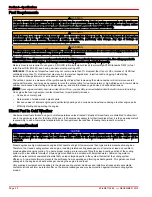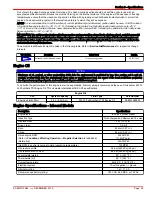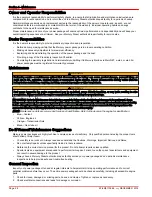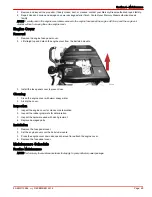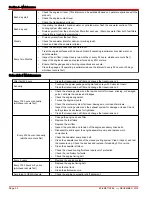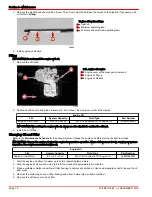
Section 2 - On the Water
90-8M0113986
eng
DECEMBER 2015
Page 17
5. Verify that all instrumentation is functioning properly and indicating normal readings.
Engine Warm Up
NOTICE
Engine wear caused by increased friction and limited oil flow is greatest when an engine is cold. Decrease engine wear by
allowing the engine coolant temperature to reach normal operating range before hard acceleration or applying full throttle.
1. After starting, ensure that all instrumentation is functioning properly.
2. Operate the engine at 1,000 to 1,200 RPM until the engine temperature is within the normal operating range. It is crucial
that any engine be warmed up before applying full load. The warm‑up period provides time for the lubricating oil to
establish a film between moving parts.
NOTE: Engine warm‑up time during cold weather can be reduced by operating the vessel at a reduced engine speed.
Begin normal vessel operation when systems reach operating temperatures.
3. After the engine has reached operating temperature:
a. The oil pressure should be within the range specified. Refer to
Section 4
‑
Engine Specifications
. Stop the engine if
the oil pressure is not within the range specified.
b. Check the fuel system for leakage from the injection pump, fuel pipes, fuel filter, or fuel lines.
c. Check the engine and the transmission, oil filter, oil lines, oil line connectors, and oil pan for leaks.
d. Check the coolant hoses, heat exchanger connections, aftercooler, water pump, and drain fittings for leaks.
4. Locate and correct any problems, or see your Mercury Diesel authorized repair facility if you are unable to determine the
problem.
Starting a Warm Engine
1. Turn on and run the engine compartment bilge blower (if equipped) for 5 minutes. Or, open the engine hatch to air out the
bilge before attempting to start the engine.
2. Place the remote control handle in neutral.
3. Turn the key switch to "START" position and release the key when the engine starts.
4. Ensure that all the instrumentation is functioning properly and indicates normal readings.
Shifting
NOTICE
Shifting into gear at engine speeds above idle will damage the transmission. Shift into gear only when the engine is operating
at idle.
NOTICE
Failure to rotate the propeller shaft when shifting gears or forcing the shift mechanism while the engine is not operating can
result in product damage. If you must shift gears with the engine off, manually rotate the propeller shaft in the appropriate
direction.
To shift the unit, verify the remote control throttle lever is in neutral. Move the remote control shift lever forward to shift into
forward gear or backward to shift into reverse. After shifting the transmission, advance the throttle to the desired setting.
Engine Shut Down (Stopping)
1. Place the remote control lever in neutral.
NOTICE
Immediately stopping the engine after high load operation can damage the turbocharger bearings. Idle the engine for several
minutes before shutdown.
2. Operate the engine at idle speed for several minutes to allow the turbocharger and engine to cool.
3. The engine can be stopped by any one of the following four methods:
a. Move the ignition key switch to the "ACCESSORY" or "OFF" position. The engine will stop and the control system will
be deactivated.
b. Depress the start/stop button, if equipped. The engine will stop and the control system will remain active.
Summary of Contents for 92-8M0069603
Page 2: ......
Page 8: ...Page iv 90 8M0113986 eng DECEMBER 2015 ...
Page 68: ...Section 4 Maintenance Notes Page 60 90 8M0113986 eng DECEMBER 2015 ...
Page 84: ......






















